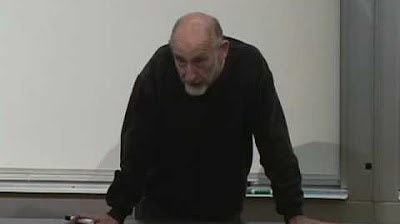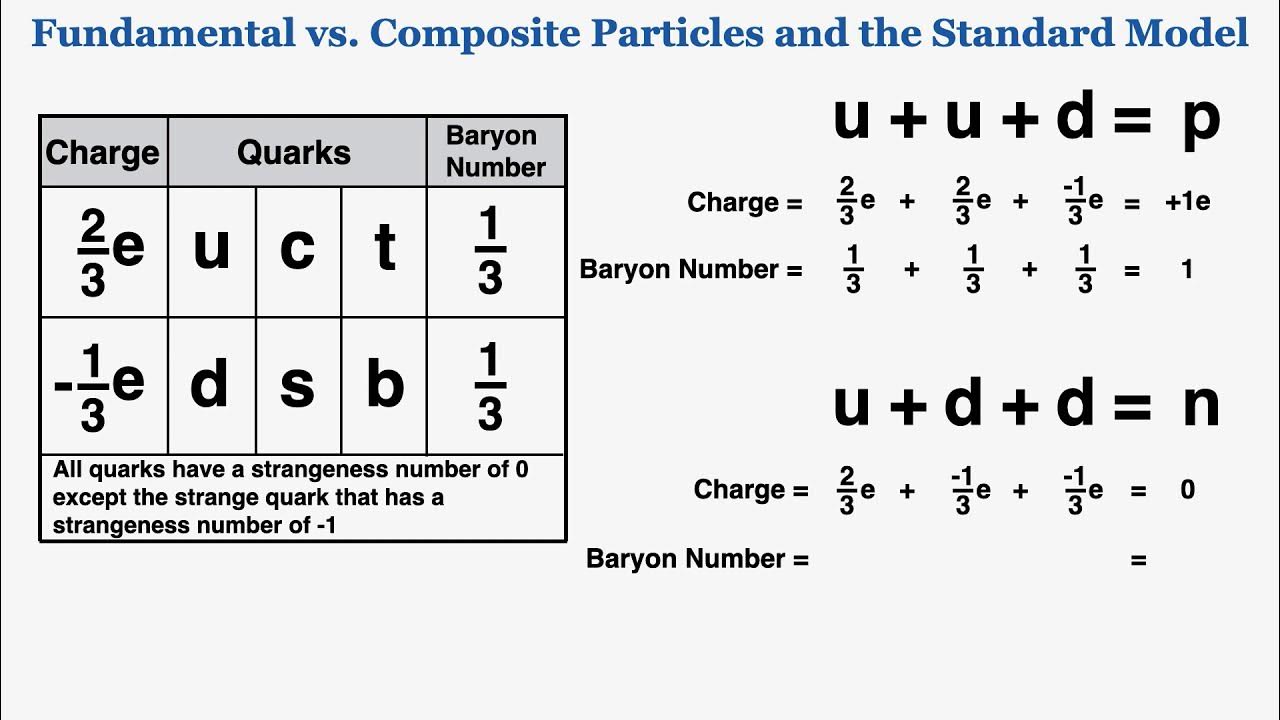Did AI Prove Our Proton Model WRONG?
TLDRThe video script delves into the complex structure of protons, revealing that they are not simple 3-quark particles but contain a dynamic 'quark sea' with transient particles. It discusses the historical discovery of quarks and the surprising finding of heavier charm quarks within protons. The script highlights the challenges in modeling proton interiors and how artificial intelligence has recently aided in suggesting a model with intrinsic charm quarks, potentially reshaping our understanding of proton composition.
Takeaways
- 🧬 Protons and neutrons are not elementary particles but are composed of quarks, which were once thought to be three in number but may sometimes appear as five, including a heavier charm quark.
- 🔬 The interior of protons remains a mystery despite being a common component of visible matter in the universe, and our understanding of their structure has evolved over time with technological advancements.
- 💡 The discovery that protons are made of quarks came about in the late 1960s, with experiments showing that protons are composed of three point-like particles matching the properties of quarks proposed by Murry Gell-Mann and George Zweig.
- 🌟 The quark model of a proton consists of two up quarks and one down quark, held together by gluons that carry the strong nuclear force, with a similar model applying to neutrons.
- 🔍 High-energy electron scattering has been instrumental in revealing the complex inner structure of protons, showing that they are not just simple collections of quarks but include a dense network of gluons and virtual quarks and antiquarks.
- 🤔 The existence of charm quarks within protons presents a conundrum, as they are heavier than the proton itself, and their detection could be due to new particle-antiparticle pairs created during high-energy collisions.
- 🧠 The Heisenberg uncertainty principle allows for the temporary creation of massive particle-antiparticle pairs, like charm quarks, inside protons, even though they exist for a very short duration and contribute minimally to the proton's mass.
- 💻 Artificial Intelligence and machine learning have revolutionized the study of protons by enabling the analysis and testing of thousands of models of proton interiors simultaneously, leading to the proposal of a model with intrinsic charm quarks.
- 🔮 A 3-sigma result in favor of intrinsic charm quarks has been reported, suggesting a 1 in 1000 chance of being a random occurrence, though a 5-sigma result (1 in a million chance) is needed for definitive proof.
- 🌐 The use of AI in experimental physics is rapidly advancing, allowing for faster development and testing of models, and aiding scientists in focusing on interpreting successful models and furthering our understanding of the subatomic world.
Q & A
What is the basic hierarchy of biological and physical composition according to the transcript?
-The basic hierarchy starts with people being made of cells, cells are composed of molecules, molecules are made of atoms, and atoms consist of electrons, protons, and neutrons. Protons and neutrons are further made up of quarks.
What revelation did the late 1960s bring about the structure of protons?
-It wasn't until the late 1960s that scientists confirmed protons were not elementary particles but were composed of three quarks.
How do physicists investigate the smallest scales of nature?
-Physicists investigate the smallest scales of nature using the physics of scattering, where they analyze the deflection of particles like electrons to infer the structure of subatomic particles.
What discovery did Earnest Rutherford make about the atom using a scattering experiment with alpha particles?
-Rutherford discovered that the atom is mostly empty space with most of its mass concentrated in a tiny central nucleus by observing how alpha particles scattered off a thin gold foil.
What is the significance of the Stanford Linear Accelerator Center (SLAC) experiments in the 1950s and 1960s?
-The SLAC experiments accelerated electrons to higher energies than ever before and observed their interactions with protons, leading to the deductive discovery of quarks as the constituents of protons.
What is the 'quark sea' within a proton?
-The 'quark sea' is the complex, constantly shifting network of gluons and virtual quarks and antiquarks within a proton, which cancel each other out except for the 'valence' quarks that make up the proton's identifiable structure.
Why was the discovery of charm quarks inside protons surprising?
-The discovery of charm quarks was surprising because they are heavier than the entire proton, which is akin to finding a more massive object inside a less massive one.
How can the Heisenberg uncertainty principle explain the existence of intrinsic charm quarks inside a proton?
-The Heisenberg uncertainty principle allows for the temporary creation of massive particle-antiparticle pairs like charm quarks inside a proton, as long as they exist for an extremely short duration and vanish again quickly.
What challenges did scientists face in confirming the existence of intrinsic charm quarks?
-The challenges included the difficulty of modeling low-energy particle collisions, the multitude of possible proton interior models leading to similar scattering predictions, and the need to test all possible models to discern if intrinsic charm was necessary to explain the data.
How has artificial intelligence (AI) contributed to the study of proton structure and charm quarks?
-AI has enabled scientists to test hundreds or thousands of models of the proton interior simultaneously, allowing for a more efficient and unbiased analysis of proton collisions and leading to the proposal of models with intrinsic charm that predict scattering data more accurately.
What is the current status of the claim that protons contain intrinsic charm quarks?
-The claim is tentative, with a 3-sigma result indicating a 1 in 1000 chance of it being a random occurrence. The gold standard of 5-sigma, which implies a 1 in a million chance, is needed for a more definitive confirmation.
How does the cooperation between artificial intelligence and human researchers benefit experimental physics?
-The cooperation allows AI to rapidly test numerous models and hypotheses, freeing up human researchers to focus on interpreting the results and gaining deeper insights into the fundamental workings of the universe.
Outlines
🧪 Delving into the Proton's Mysteries
This paragraph explores the complex structure of protons, starting from the common understanding that protons are made of three quarks. It challenges this notion by introducing the concept that protons may sometimes consist of five quarks, including the heavier charm quark. The discussion highlights the journey of scientific understanding of protons, from the initial discovery of quarks in the 1960s to the modern explorations using AI-enhanced models. The paragraph emphasizes the profound mystery that still surrounds the interior of protons and the importance of high-energy scattering experiments in uncovering their subatomic structure.
🌀 The Intricate Quark Sea within Protons
The second paragraph delves deeper into the proton's interior, revealing it as a dense network of gluons and virtual quarks and antiquarks, known as the quark sea. It describes the dynamic and chaotic nature of this subatomic environment, where quarks constantly transform and annihilate each other. The paragraph also discusses the discovery of charm quarks within protons, which defies the initial understanding of proton composition. It touches on the challenges faced in confirming the existence of intrinsic charm quarks due to the complex calculations involved in quantum chromodynamics (QCD) and the limitations of traditional experimental methods.
📈 Theoretical Explorations and AI's Role
This paragraph discusses the difficulties in modeling the low-energy state of protons and the role of the Heisenberg uncertainty principle in the potential existence of intrinsic charm quarks. It explains how the principle allows for the temporary creation of massive particle-antiparticle pairs, such as charm-anticharm quarks, inside protons. The paragraph then highlights the breakthrough use of artificial intelligence (AI) in the NNPDF collaboration, which enabled the simultaneous testing of thousands of proton interior models. The AI's success in finding a model with intrinsic charm that predicts collision data more accurately than previous models is emphasized, although the results are still tentative and require further validation.
🚀 Future Prospects in Proton Research
The final paragraph discusses the potential future of proton research, suggesting that the continued use of machine learning and AI could lead to a better understanding of the proton's charm quark composition. It emphasizes the rapid development of these technologies and their ability to test numerous models faster than traditional methods, allowing physicists to focus on interpreting successful models. The paragraph concludes with a nod to the collaborative efforts between artificial and natural intelligences in unraveling the mysteries of the subatomic world.
Mindmap
Keywords
💡Quarks
💡Protons
💡Neutrons
💡Quantum Chromodynamics (QCD)
💡Scattering
💡Charm Quark
💡Heisenberg Uncertainty Principle
💡Artificial Intelligence (AI)
💡Neural Networks
💡Intrinsic Charm
💡E=mc^2
Highlights
People are made of cells, cells are made of molecules, molecules are made of atoms, and atoms are made of electrons, protons, and neutrons.
Protons and neutrons are actually made of many quarks that appear as three quarks when viewed in a certain way.
The humble proton, a common component of visible matter in the universe, has a complex and mysterious interior.
Protons are not elementary particles but are composed of three quarks, a discovery confirmed in the late 1960s.
Modern AI has provided evidence suggesting protons may sometimes be made of five quarks, including the charm quark.
Understanding the physics of scattering is key to probing the smallest scales of nature.
The process of seeing is akin to performing a scattering experiment, with photons interacting with objects and being detected by our eyes.
Higher energy scattering allows us to observe smaller objects, such as subatomic particles.
The discovery of the nucleus by Earnest Rutherford was a scattering experiment using alpha particles on gold foil.
Electron microscopes are a modern application of scattering experiments to study the structure of samples at the subatomic level.
The Stanford Linear Accelerator Center (SLAC) experiments in the 50s and 60s led to the understanding that protons are made of quarks.
The interior of the proton, known as the quark sea, is a complex network of gluons, virtual quarks, and antiquarks.
The valence quarks in a proton are constantly exchanging energy and color charge with the quark sea.
As the energy of the electron beam increases in scattering experiments, finer details of the proton's interior become visible.
There is evidence of charm quarks inside protons, which is surprising since they are more massive than the proton itself.
The energy carried by an electron can create new particles when it interacts with a proton, as mass and energy are interchangeable (E=mc^2).
Intrinsic charm quarks may exist momentarily inside a proton due to the Heisenberg uncertainty principle, allowing for the creation of massive particle-antiparticle pairs.
Artificial Intelligence has enabled scientists to test thousands of models of the proton interior simultaneously, leading to the discovery of a model with intrinsic charm that predicts data better than previous models.
The NNPDF collaboration used a neural network to analyze nearly 30 years of proton collisions, significantly speeding up the process of model testing.
The current model with intrinsic charm has a 3-sigma result, indicating a 1 in 1000 chance of being wrong, and further experiments are needed for confirmation.
Transcripts
Browse More Related Video
5.0 / 5 (0 votes)
Thanks for rating:





